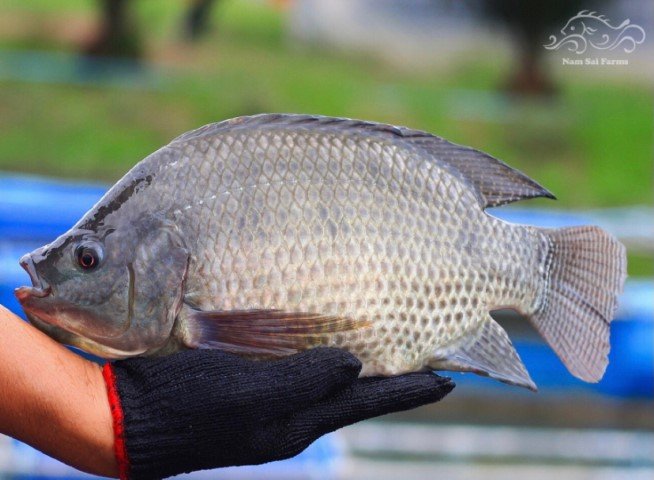Tilapia is one of the most important aquaculture species, contributing to food security and economic development throughout the tropics. For practical and economic reasons, hatchlings commonly receive a short period of hormone treatment to produce all-male stocks for growout. Whilst the quantities involved are very small and result in no detectable increase in hormone levels in harvested fish, there are some regulatory barriers, and ongoing concerns on grounds of welfare, staff health and safety or environmental effects.
Red tilapia in cages in a Thailand river (Photo: Nam Sai Farms)
Under the leadership of Professor David Little, a potential alternative strategy using mixed-sex production was examined through a practical growth trial at Nam Sai Farms in Thailand, and economic modelling and nutritional research at the Institute of Aquaculture. The trials also facilitated an MSc student project, which was carried out by Armah Dorcas Mensah from Ghana; supporting valuable transfer of knowledge from Asia to Africa. The “Big Nin” strain of Nile tilapia was selected for the trial due to its fast growth rate and good fillet yield. In the main growout stage, average fish weight increased from 45g to around 1 kg in 20 weeks.
The Big-Nin strain of Nile tilapia (Photo: Nam Sai Farms)
The trials compared growth, overall production and other parameters for four treatments (culture strategies). Firstly conventional all-male fish at standard stock density. Secondly mixed-sex fish at standard stock density. Thirdly mixed sex fish stocked at double density, but with removal of identified females every four weeks. Fourthly mixed sex fish stocked and double density with removal of identified females every 8 weeks.
Experimental strategy
The best growth was observed in the all-male tilapia cages. However, the growth of the males in mixed-sex culture was almost equivalent and within the margins of experimental error. The growth of females was substantially lower as might be expected, reducing the harvest biomass of the standard mixed-sex population considerably. However, the strategy of double-stocking and then removing females was very effective and provided a higher overall yield of fish.
Proportions of males and females in each treatment and final average weight
A financial model was then developed to explore the implications of these results for commercial farmers. This showed that the production of monosex fish was the most profitable strategy given market prices in Thailand. However, if an 8% premium can be obtained for non-hormone treated fish, then a mixed-sex strategy could give equivalent financial results. Alternatively, if the removed females can be sold at a price higher than their cost of production, then again mixed-sex production would be financially viable. However, the market price of small fish is usually lower per kg than large fish, so this can be challenging. The exception would be small females sold for potential broodstock, as these command much higher prices. However, the demand for these is limited and may be constrained by biosecurity issues.
Comparing contributions to total earnings for different scenarios: (a) base case, (b) if all removed females are sold at Thailand prices, (c) if all removed females can be sold at higher Bangladesh prices and (d) if all removed females can be sold as potential broodstock
Whilst these findings will not immediately encourage adoption of mixed-sex production for small and medium scale producers in Thailand, they may be more interesting for larger commercial producers that are targeting more sophisticated urban or international markets sensitive to messaging on production methods. Particularly if producing in areas where smaller female fish could find a ready market. For instance, prices per kg for small tilapia in African countries can be double that found in Asia.
Read more in the recently published Aquaculture article: "Mixed-sex Nile tilapia (Oreochromis niloticus) can perform competitively with mono-sex stocks in cage production". https://doi.org/10.1016/j.aquaculture.2022.738315





